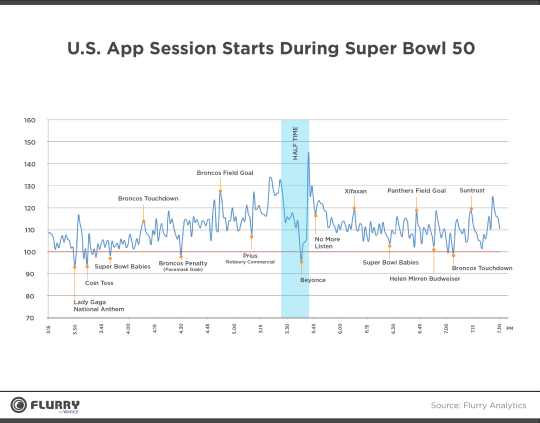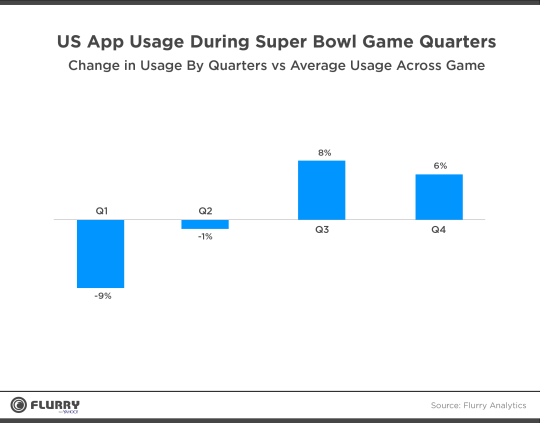Smartphone Usage Skyrockets during Super Bowl 50
By Chris Klotzbach, Head of Product Marketing, Flurry
Super Bowl 50, played in the heart of Silicon Valley in Santa Clara, CA, proved to be the most mobile of all Super Bowls to-date. Viewers watched with their smartphones in hand more so than any given Sunday* or previous Super Bowls on record.
While the Denver Broncos took the Vince Lombardi Trophy in the end, the real winner of Super Bowl 50 was halftime guest performer Beyonce, whose two minute solo contribution commanded the most undivided viewer attention over the four hour game.
As we’ve done in years past, Flurry from Yahoo examined app usage activity during The Big Game. In this report we analyze how what was happening throughout the game, affected viewers’ engagement with their phones.
Beyoncé Runs The (Mobile) World

Before the start of Coldplay’s halftime performance during the NFL’s halftime commentator report, we observed a spike in app activity, but Coldplay’s initial solo act (and then addition of Bruno Mars) brought smartphone activity back down to Super Bowl 50 average. Only when Beyoncé joined the performance did viewers put their smartphones down, with our session index dropping the lowest throughout the game. Viewers immediately re-engaged with their smartphones at 5:39pm when Coldplay retook the stage alone. One can argue that anticipation and excitement for Beyoncé, due to her previous Super Bowl performance and the release of her new song, Formation, the day before the game, piqued viewer interest.
While both years’ halftime performances commanded viewers’ attention, Katy Perry in 2015 initial appearance immediately prompted viewers to put their smartphones down, but attention eased while her act when on. While 2016 headliner Coldplay slowly engaged the audience, it was Beyoncé’s guest appearance that cut mobile usage by a third (33.8% decrease) during her mere two minutes on-screen.
Super Bowl 50: A True Dual Screen Experience

When comparing Super Bowl 49 to this year’s event, we observed a 21% year-over-year increase in session activity during the game. Furthermore, the sessions during the game this year over-indexed a regular Sunday by 11% versus 4% for the same comparison last year. In 2015, there were 77 occurrences where phone use engagement dipped below the average Sunday’s app activity. During this year’s game, we observed only eight instances where mobile use dropped below the Sunday average, one of which occurred before the game started, during Lady Gaga’s National Anthem performance. Almost consistent over-indexed user engagement with apps throughout the game allows us to call this year’s game a true dual screen experience.
Spikes and slumps across all four quarters were more often that not attributed to fouls, fumbles and touchdowns, versus active game play. An example of this is Aqip Talib’s facemask grab and subsequent penalty in the second quarter at 4:30pm, which proved to be the most engaging TV moment of that quarter. The Bronco’s field goal that same quarter, at 4:52pm, was a high point for app activity (lowest engaging TV moment).
Overall viewer reaction to ads was varied, but the two things that did make us stop and watch was shock factor and emotional appeal. Viewers immediately turned to their phones after viewing the Toyota Prius bank robbery and chase commercial and the Xifaxan Irritable Bowel Mascot spot. The “Super Bowl Babies” teaser and full run, as well as Suntrust’s first ever Super Bowl Ad had viewers taking to their phones, as well. Commercials with a conscience appealed to viewers as well, with NOMORE.org’s “Listen” at 5:46pm catching viewers’ attention during an otherwise high app activity time between the halftime show and the start of the 3rd quarter.
Where Can Advertisers Compete? (Answer: Not With Beyoncé)
The Super Bowl provides marketers double the opportunity to speak to their consumers; as viewers’ engage with both their TV set and smartphone devices.

We’ve determined that the 1st and 2nd quarters have the most viewers tuned to their their TVs; thus making TV ad dollars go further. Running an advertisement during the 3rd quarter has your TV spot least likely to make its mark, but offers a great opportunity to spread your marketing message via mobile push notifications. Viewers’ attention shifts slightly back towards the game in the 4th quarter, but remains predominantly a dual screen experience through the end of the game.
*About this Study
Flurry from Yahoo indexed minute-by-minute app session starts of US devices (as defined by when a user launches an app or brings it to the foreground) from 3:15 p.m. to 7:30 p.m. Pacific time during Super Bowl 50. The index is based on the average app session starts of the previous three Sundays in January in order to control for normal app usage fluctuations. In this case a value of 100 means the app activity during the Super Bowl was equal to the average app activity of the previous three Sundays. Flurry Analytics tracks 800,000 apps and sees an average of 10 billion sessions per day worldwide.